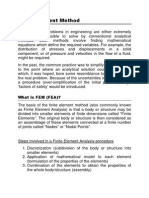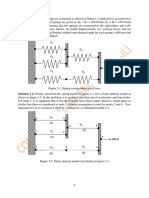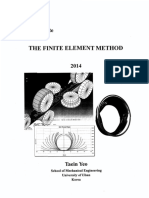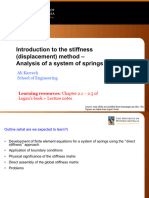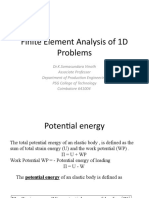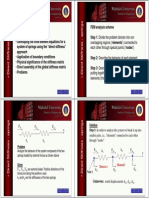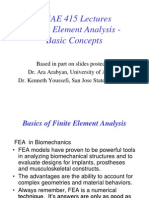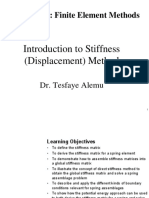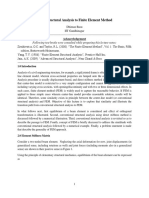0 ratings0% found this document useful (0 votes) 50 views13 pagesLecture Notes 1TOS5 Theory of Structures
Copyright
© © All Rights Reserved
We take content rights seriously. If you suspect this is your content,
claim it here.
Available Formats
Download as PDF or read online on Scribd
Introduction
© The matrix stiffness method is the basis of almost all commercial
structural analysis programs.
« Itisa specific case of the more gencral finite element method and was
in part responsible for the development of the finite element method.
Basic Concepts
Node
« The more general name for a connection between adjacent members
is termed a node.
« For trusses and frames the terms joint and node are interchangeable.
For more complex structures (e.g. plates), they are not.
Element
For trusses and frames element means the same as member. For more
complex structures this is not the case.
Degree of Freedom
The number of possible directions that displacements or forces at a node
can exist in is termed a degree of freedom (dof). Some examples are:�Plane truss: has 2 degrees of freedom at each node: translation/forces in
the x and y directions,
Beams: have 2 degrees of freedom per node: vertical displacement/forces
and rotation/moment.
Plane Frame: has 3 degrees of freedom at each node: the
translations/forces similar to a plane truss and in addition, the rotation or
moment at the joint.
Space Truss: a truss in three dimensions has 3 degrees of freedom:
translation or forces along each axis in space.
Space Frame: has 6 degrees of freedom at each node: translation/forces
along each axis, and rotation/moments about each axis.
Thus a plane truss with 10 joints has 20 degrees of freedom. A plane frame
with two members will have three joints (one common to both members)
and thus 9 degrees of freedom in total.
Local and Global
« Forces, displacements and stiffness matrices are often derived and
defined for an axis system local to the member.
« However there will exist an overall, or global, axis system for the
structure as a whole.�¢ We must therefore transform forces, displacements etc from the local
coordinate system into the global coordinate system.
‘Types of Finite Elements 2D Plane) Element
FD ina omen <>
ee hs
(Spring, truss, beam, pipe, etc.) (Membrane, pat, shall, ete)
$0 Gol Element |
wet beled lotr
LT eat
XY
Ba
(-D fields - temperature, displacement, stress, ow velocity)
Elements & Nodes - Nodal Quantity
Basic Approach
Individual Element
* We consider here the most basic form of stiffness analysis. We
represent a structural member by a spring which has a node (or
connection) at each end.
¢ We also consider that it can only move in the x-direction.
© Thus, it only has 7 DOF per node, At each of its nodes, it can have a
force and a displacement (again both in the x-direction): Notice that we�have drawn the force and displacement vector arrows in the positive
xdirection.
Matrix analysis requires us to be very strict in our sign conventions.
Using the basic relationship that force is equal to stiffness times
displacement, we can determine the force at node | as:
Fores, f
hood ft 2 ft * Deflection, 8 =
io (
(a) Linear spring element with nodes, nodal displacements, and nodal forces.
(b) Load-deflection curve,
G a) Le y f _& de)
i�Assuming that both the nodal displacements are zero when the spring is
undeformed. the net spring deformation is given by
ty
and the resultant axial force in the spring is
f= kO=Kuy—m)
For equilibrium,
fir~h=0 0 =f.
Then, in terms of the applied nodal forces as
fi= ak un)
f= ky, — 1)
Which can be expressed in matrix form as
[i THe e{ ff = wow =tn
where
k Tk
[kel = [ pg ] Stiffness matrix for one spring element
is defined as the element stiffness matrix in the element coordinate system (or local
system), {u} is the column matrix (vector) of nodal displacements, and { (} is the
column matrix (vector) of element nodal forces
Assemblies of Elements
Consider the following simple structure:
(4,40) "7 od Wp Ch, ets)
4 Zz leg 3
Thus we can write the force displacement relationships for both elements as:�fk -k]fu is
“l-k kw (15)
7 k, -k, |{u, 16
[5 ky Ke} ns
we can write the force displacement relationships for both elements as:
F) [kk -k OJfu,
Fh=|-k k ORw, (1.7)
FJ} [0 0. Offu,
F) fo 0 0)fu,
Fb=|0 kk, Hu, (1.8)
FJ lo -& &, |lu
We can add equations (1.7) and (1.8) to determine the total of both the forces and
displacements at each node in the structure:
F, k, -k, 0 Ju,
Fyp=|-k, ky +k, -k, |p,
F) Lo -& & Sly
As can be seen from this equation, by adding, we have the total stiffness at each
node,with contributions as appropriate by each member. In particular node 2,�where the members meet, has total stiffness kl + k2 . We can re-write this
equation as:
{F}=[K]{u} (1.10)
In which:
© {F} is the force vector for the structure;
¢ [K] is the global stiffness matrix for the structure;
© {u} is the displacement vector for the structure.�Example 1.1
Given: _ For the spring system shown above.
k,=100N/mm, k,=200N/mm, k, =100N/mm
P=500N, =u, =0
Find: (a) the global stiffness matrix
(b) displacements of nodes 2 and 3
(©) the reaction forces at nodes 1 and 4
(@) the force in the spring 2
Solution
(a) The element stiffness matrices are
_[ 100-1007 A, 1
*=|-100 100 | @
ome | atm) o
-200 200 aa
ss
100-100 i 5
-100 100 | “= 8)�Applying the superposition concept, we obtain the global stiffness
matrix for the spring system as
4,
I u, 4, uy
100°” “160 0 0
+100 100+200 —200 oO
“| 0 = 200 2004 100" 100)
o oO —100. 100.
or
100 -100 0 0
-100 300 -200 0
0 200 300 -100
0 0 -100 100
which is symmetric and banded.
Equilibrium (FE) equation for the whole system is
100 -100 0 0 Tu, .
=100 300-200 9 ||u| _ Jo
0-200 300 -100/}1, “|p
0 0 ~100 100 Jiu) LF
() Applying the BC (1, =1, =0) in Eq(4), or deleting the 1” and
4® rows and columns, we have�300 —200]{u, oO
ia
{+200 300 fluJ~ LP.
Solving Eq.(5), we obtain
| _ [P1250] _ [2 i é
uf 7 |3P/500{ 7 |3f @™ a
(c) From the 1° and 4" equations in (4), we get the reaction forces
200 (N)
300 (N)
F,=—100u
F, =—100u.
(d) The FE equation for spring (element) 2 is
[ 200 co {f|
{+200 200 }lu,J~ LF,
Here i= 2, j=3 for element 2. Thus we can calculate the spring
force as
F=f,=-f,-[-200 zon}
Us
=[-200 zon}
200 (N)�Example 1.2
Problem: For the spring system with arbitrarily numbered nodes
and elements, as shown above, find the global stiffness
matrix.
Solution:
First we construct the following
Element Connectivity Table
Element | Nodei (1) | Nodej (2)
T 4 2
Huw
which specifies the global node numbers corresponding to the
Toca node numbers for each element.
Then we can write the element stiffness matrices as follows�wy uy
k,
ky :
ky
My Us uu,
x,=[%
aes
Finally, applying the superposition method, we obtain the glol
stiffuess matrix as follows
% uy ts
ki -k | 0 0 0
—k, htk+k —-k —k 0
K=| 0 “ig +k 0 ky
0 ~k, ORO
oo TREO
The matrix is symmetric, banded, but singular.�
